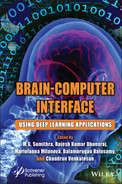Preface
The Brain-Computer Interface (BCI) is an emerging technology that is developing to be more functional in practice. The aim is to establish, through experiences with electronic devices, a communication channel bridging the human neural networks within the brain to the external world. For example, creating communication or control applications for locked-in patients who have no control over their bodies will be one such use. Recently, from communication to marketing, recovery, care, mental state monitoring, and entertainment, the possible application areas have been expanding. Machine learning algorithms have advanced BCI technology in the last few decades, and in the sense of classification accuracy, performance standards have been greatly improved. For BCI to be effective in the real-world, however some problems remain to be solved.
The book provides the reader with the fundamental theories, concepts, and methods in neuroscience, brain recording and stimulation technologies, signal processing, and machine learning. Readers have the chance to review their knowledge and assess their comprehension of the subjects presented in each chapter with exercises and questions at the end of each chapter. Some assignments provide the student the option to explore topics outside of those covered in the textbook by looking for new information online and following leads in research articles. Highlighting most of the research directions in the digital world, this book is more suitable for researchers from biomedical background, data analysts, AI researchers, machine and deep learning engineers, students and academicians.
The book is organized as follows: In chapters 1 and 2 provides an introduction to Brain–Computer Interface: Applications and Challenges. Chapter 3 discusses the statistical learning of brain compute interface was discussed. Chapter 4 begins with the impact of brain computer interface on the lifestyle of elderly people. Chapter 5 reviews the innovation to human augmentation in brain computer interface and its potential limitations in artificial intelligence. Chapter 6 details the Resting-State fMRI: large data analysis in neuro imaging. Chapter 7 describes early detection of epileptic seizure using deep learning algorithms. Chapter 8 describes the application of brain computer interface based on the real time upper limb protheses to improve the quality of the elderly. Chapter 9 describes another application of brain computer interface to assisted automated wheelchair control management. Chapter 10 shows the application of convolutional neural network to identify Bengali vowels from EEG signal using activation map. Chapter 11 discusses the optimized feature selection techniques for classifying electrocorticography signals. Chapter 12 reviews some of the challenges, application and advancements in brain computer interface.
The editors thank all contributors for their time and effort and have collectively delivered high quality work.
